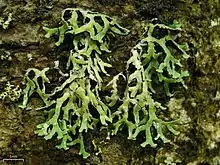Anzia
Anzia is a genus of lichenised ascomycetes in the large family Parmeliaceae. It was formerly included in the monogeneric family Anziaceae, but this has since been subsumed into the Parmeliaceae.[2]
| Anzia | |
|---|---|
 | |
| Anzia colpodes | |
| Scientific classification | |
| Kingdom: | Fungi |
| Division: | Ascomycota |
| Class: | Lecanoromycetes |
| Order: | Lecanorales |
| Family: | Parmeliaceae |
| Genus: | Anzia Stizenb. (1861) |
| Type species | |
| Anzia colpodes (Ach.) Stizenb. (1862) | |
| Synonyms[1] | |
| |
Description
Members of Anzia have a foliose growth form, with a thallus that can anywhere from 2–30 cm (0.8–11.8 in) wide. It is one of the only groups in the family not to have 8 spores in each ascus, but instead has numerous spores in each ascus (varying slightly from ascus to ascus).
Distribution
The genus has a cosmopolitan distribution, but is concentrated in the Northern Hemisphere, particularly in Japan.[3]
Evolutionary history
A fossilized Anzia, Anzia electra, was found in 35–40 Myr-old Baltic amber. Its features suggest that the main distinguishing characteristics in the thallus morphology of section Anzia have been retained for tens of millions of years.[4]
Species
- Anzia colpodes (Ach.) Stizenb. (1862)
- Anzia electra Rikkinen & Poinar (2002)
- Anzia flavotenuis Jayalal, Wolseley & Aptroot (2012)
- Anzia gallowayi Elix (2007)
- Anzia hypomelaena (Zahlbr.) Xin Y.Wang & Li S.Wang (2015)
- Anzia isidiosa Yoshim. (1995)
- Anzia mahaeliyensis Jayalal, Wolseley & Aptroot (2012)
- Anzia minor Yoshim. (1992)
- Anzia pseudocolpota Xin Y.Wang & Li S.Wang (2015)
- Anzia rhabdorhiza Li S.Wang & M.M.Liang (2012)
- Anzia tianjarana Yoshim. & Elix (1992)
References
- "Synonymy: Anzia Stizenb". Species Fungorum. Retrieved 11 December 2020.
- Crespo, A.; Lumbsch, H. T.; Mattsson, J. E.; Blanco, O.; Divakar, P. K.; Articus, K.; Wiklund, E.; Bawingan, P. A.; Wedin, M. (2007). "Testing morphology-based hypotheses of phylogenetic relationships in Parmeliaceae (Ascomycota) using three ribosomal markers and the nuclear RPB1 gene". Molecular Phylogenetics and Evolution. 44 (2): 812–824. doi:10.1016/j.ympev.2006.11.029. PMID 17276700.
- Galloway, D.J. (2007). Flora of New Zealand - Lichens - Revised 2nd Edition http://floraseries.landcareresearch.co.nz/pages/index.aspx
- Rikkinen, Jouko; Poinar, George O. (2002). "Fossilised Anzia (Lecanorales, lichen-forming Ascomycota) from European Tertiary amber". Mycological Research. 106 (8): 984–990. doi:10.1017/S0953756202005907.